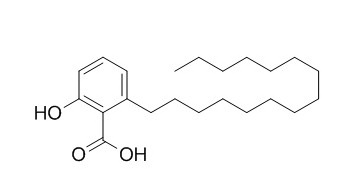Ginkgolic acid C15:0
Reference standards.
Inquire / Order:
manager@chemfaces.com
Technical Inquiries:
service@chemfaces.com
Tel:
+86-27-84237783
Fax:
+86-27-84254680
Address:
1 Building, No. 83, CheCheng Rd., Wuhan Economic and Technological Development Zone, Wuhan, Hubei 430056, PRC
Providing storage is as stated on the product vial and the vial is kept tightly sealed, the product can be stored for up to
24 months(2-8C).
Wherever possible, you should prepare and use solutions on the same day. However, if you need to make up stock solutions in advance, we recommend that you store the solution as aliquots in tightly sealed vials at -20C. Generally, these will be useable for up to two weeks. Before use, and prior to opening the vial we recommend that you allow your product to equilibrate to room temperature for at least 1 hour.
Need more advice on solubility, usage and handling? Please email to: service@chemfaces.com
The packaging of the product may have turned upside down during transportation, resulting in the natural compounds adhering to the neck or cap of the vial. take the vial out of its packaging and gently shake to let the compounds fall to the bottom of the vial. for liquid products, centrifuge at 200-500 RPM to gather the liquid at the bottom of the vial. try to avoid loss or contamination during handling.
Environ Toxicol.2022, 37(3):514-526.
Universidade Estadual Paulista2017, 11449
Sci Rep.2024, 14(1):23786.
Journal of Third Military Medical University2018, 40(12):1073-1078
Exp Biol Med (Maywood).2019, 244(16):1463-1474
Pharmaceuticals (Basel).2020, 13(10):302.
Molecules.2022, 27(19):6651.
Journal of Food Engineering2024, 379:112136.
Foods.2023, 12(6):1227.
Antioxidants (Basel).2024, 13(3):340.
Related and Featured Products
Journal of Luminescence Volume 132, Issue 5, May 2012, Pages 1207–1214
Spectroscopic studies on the interaction of bovine serum albumin with ginkgolic acid: Binding characteristics and structural analysis[Reference:
WebLink]
The interaction between Ginkgolic acid C15:0 and bovine serum albumin (BSA) is investigated by several spectroscopic methodologies.
METHODS AND RESULTS:
At first, the binding characteristics of Ginkgolic acid C15:0 and BSA are determined by fluorescence emission spectra. It is showed that Ginkgolic acid C15:0 quenches the fluorescence of BSA and the static quenching constant KLB is 11.7891×104 L mol−1 s−1 at 297 K. Ginkgolic acid C15:0 and BSA form a 1:1 complex with a binding constant of 9.12×105 L mol−1. Ginkgolic acid C15:0 binds to the Sudlow's drug binding site II in BSA, and the binding distance between them is calculated as 1.63 nm based on the Förster theory. The thermodynamic parameters indicate that the interaction between BSA and Ginkgolic acid C15:0 is driven mainly by hydrophobic forces. On the other hand, structural analysis indicates that Ginkgolic acid C15:0 binding results in an increased hydrophobicity around the tryptophan residues of BSA as revealed by the synchronous fluorescence spectra, and a decrease in α-helix as revealed by the far-UV CD spectra. In addition, ANS, UV–vis and RLS experiments confirmed that Ginkgolic acid C15:0 binding causes a certain structural changes in BSA.
CONCLUSIONS:
These findings provide the binding information between BSA and Ginkgolic acid C15:0), and may be helpful for pharmacokinetics and the design of dosage forms of Ginkgolic acid C15:0.



